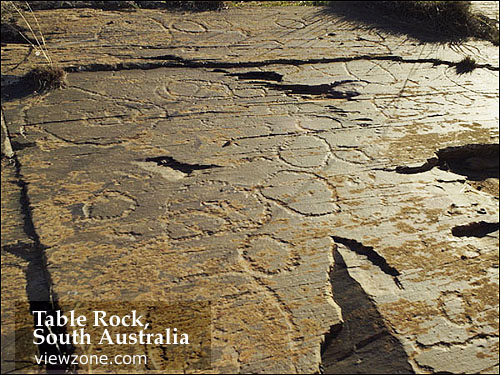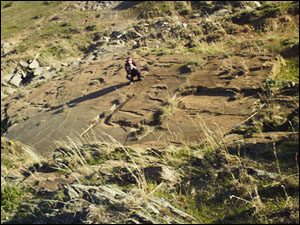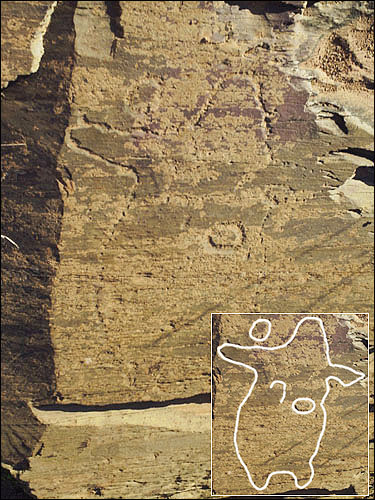

|
ViewZone was in South Australia to investigate some very old petroglyphs that were carved on the rocks in the Flinders Range. Our host. John McGovern, had sent us photographs of some of the sites and it appeared that they contained the same shapes and symbols as the sites we had visited in Colorado, Brazil and Yemen. We had even translated several intact scripts using the old proto-Canaanite language, and we were hopeful to validate these before making any kind of statement. On the way to the Flinders Range, a beautiful but extremely remote mountain range north of Adelaide, we stopped to see another ancient site with petroglyphs. The locals call it "table rock" because the site is dominated by a large flat rock that resembles a table.

The images, mostly circular shapes, had been pecked into the flat stone eons ago. There was thick dark varnish covering the petroglyphs and they were well worn by the wind and rain. It was almost impossible to see them unless you positioned yourself so the Sun was able to cast shadows where the flat surface had been carved. Then, they were quite visible and easy to photograph.
In Australia, "old" means "very old." Some of the Aboriginal people make reference to the last Ice Age when they give the family narratives -- and that was 30,000 years ago! We photographed the circles and lines but we had little appreciation for what they meant until one of our explorers climbed to an elevated rock cliff adjoining the table.
"It's like a movie."
Viewed up close, each circle seemed meaningless. But when the entire rock was viewed as a completed work it told a story. Each collection of circles was like a frame in an animation or a comic book story. The circles moved from side to side and up-and-down and danced around a stationary point. Some of the circles had radiating lines surrounding them. These movements were recorded on the rock.
The Aboriginal mind is specialized for Australia. John did his best to explain how these petroglyphs were likely part of the "dreamtime," or collective memory. Just as spiders know how to build their web, birds of a particular species can build a uniquely shaped nest or butterflies can return to the same migration sites as their ancestors, the Aboriginal people have incorporated certain memories in their genes. These memories are not "learned," in our way of understanding the word. They are "triggered" by certain rituals or by special images at which point they are made conscious, just as if they were learned through direct experience.
These circles were likely part of this phenomenon.
I couldn't help but think of the lights in the sky we had seen in Yemen and their similar movement. I dared to think that this site contained a record of similar encounters with glowing orbs. Could these lights be that old? Have they always been here? Have other civilizations recorded them?
The glowing orbs we had seen in Yemen and on John's farm had also appeared to me to be living things. No, they didn't have arms and legs or even a head but they seemed aware and sentient. Perhaps there is no more effective way to explain this in stone than to draw a crude figure that resembles a human -- but yet is different.
As we left the slab, John showed me a place where the earth was bright red. He explained that the area was rich in ochre, a substance that was often used to paint the body in ancient rituals and which had been found in ancient graves all over the globe. Ochre is not only a colorful substance but it is made from tiny crystals and has some unusual electrical properties. I scooped some for a souvenir.
As I collected the ochre, John told me that the Aboriginal people believed that it was necessary to cover the body with ochre when confronting deity. To be in the presence of higher spirits was harmful with no protection. He suggested that perhaps ochre was used when contacting the "management" in past times -- a ritual that was repeated all over the world in burials. What better way is there to prepare to meet God than to be appropriately dressed? It was an interesting idea.
|
 We noticed that the circles and shapes appeared to be carved over pre-existing petroglyphs that had all but worn away with the passing of time. The newer petroglyphs were thousands of years old, so the older ones were extremely old.
We noticed that the circles and shapes appeared to be carved over pre-existing petroglyphs that had all but worn away with the passing of time. The newer petroglyphs were thousands of years old, so the older ones were extremely old. In the last "frame" of this slab there was a curious image that caught my eye. One of the circular shapes repeated as the image was read from right to left. Each time the round shape became more distorted until the final shape resembled a crude figure with a head, two arms and two legs. It was as if the circle had morphed and become like a human.
In the last "frame" of this slab there was a curious image that caught my eye. One of the circular shapes repeated as the image was read from right to left. Each time the round shape became more distorted until the final shape resembled a crude figure with a head, two arms and two legs. It was as if the circle had morphed and become like a human.